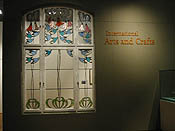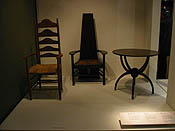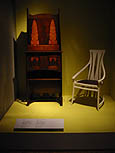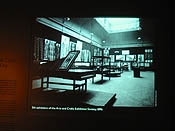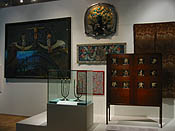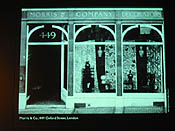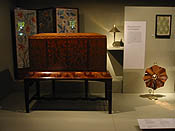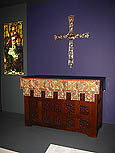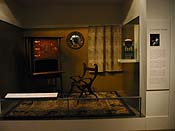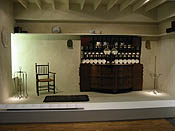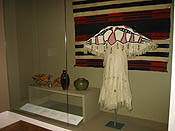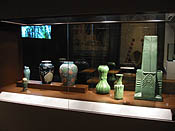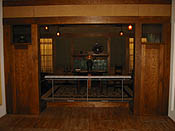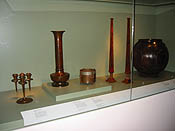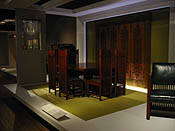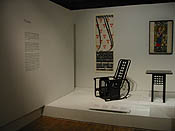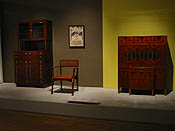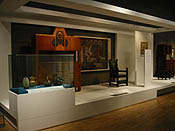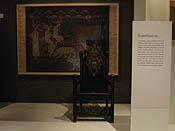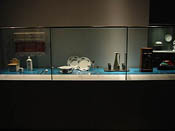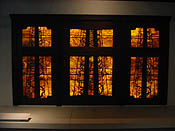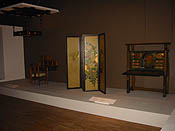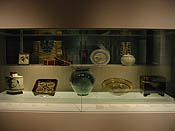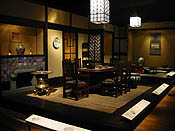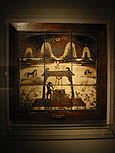The browser will either open the file, download it, or display a dialog.
|
International Arts and Crafts Karen Livingstone and Linda Parry, eds. |
|||
|
|
"Arts and Crafts was one of the most influential, profound, and far-reaching design movements of modern times." With this statement, the Victoria and Albert Museum (V & A) begins its third in a series of shows exploring modern styles of the late-nineteenth and twentieth centuries, following Art Nouveau in 2000, and Art Deco in 2003. From London it travels to the Indianapolis Museum of Art (27 September – 22 January 2006) and the Fine Arts Museums of San Francisco de Young (18 March – 18 June 2006). Karen Livingstone and Linda Parry admirably curated the show with a team of colleagues and twenty-three authors of catalogue essays who assuredly played a role in the exhibition checklist. Together, they have produced a comprehensive exhibition that explores the widespread impact of the Arts and Crafts movement. | ||
| Arts and Crafts was pervasive as a social and artistic movement. For artisans it extolled the virtues of honest workmanship, truth to materials, and, ideally, individual hand craftsmanship. For patrons it instilled an appreciation of art in everyday life and the simplicity of form and decoration. It emphasized social reform through workshop practices instead of dehumanizing mass production and industrialization. It promoted original, innovative designs rather than slavish revivals and exaggerations of earlier artistic styles. The name originated with the Arts and Crafts Exhibition Society, founded in London in 1887 as a group of like-minded artists, designers, architects, and craftsmen who expressed their reform principles through public lectures and exhibitions of objects. From Britain, the Arts and Crafts movement spread to America, continental Europe, and even Asia by the second quarter of the twentieth century. | |||
| The London venue of the exhibition includes more than 300 objects with a vast range of type and medium, including glass, ceramics, textiles, silver, furniture, metalwork, jewelry, architecture, photography, books, paintings, sculpture, and prints. Works come from museums and private collections throughout the world, with approximately one third from the rich holdings of the V & A, justifiable considering they are the organizing institution. Architects Allies and Morrison, who are responsible for the restoration of Blackwell, a British Arts and Crafts estate, designed the exhibition. The art is varyingly displayed, providing consistently fresh perspectives. Floor carpets hang like paintings and the works of art that they truly are. Rural handicrafts are juxtaposed with urban, sophisticated exhibition pieces, creating dialogues between seemingly dissimilar materials. Objects are presented as free standing sculptural masterworks; collectively as if in a department store; and tastefully arranged in four livable period rooms (two British, one American, and one Japanese). | |||
| Mindful of its audience and considerate of their time and levels of interest, the V & A provides visitors with various ways to process information. The hundreds of objects in the exhibition are thankfully given ample space to be appreciated individually, or grouped together if relevant to a room setting. Exhibition walls are arranged to help break the monotony of snaking through the three large galleries, offering the public an opportunity to look ahead or back in making points of comparison between objects. The instructive object labels list tombstone information (name, date, designer, country of origin, etc.) in addition to history of exhibition or ownership, and extended text. This allows curators to expound on objects and offer connections, should people wish to read about them. Large format labels on take-away cards also ably assist visitors. An audio guide, available for a nominal fee, presents even more information and associations on twenty-one stops throughout the exhibition that highlight certain objects and discuss important designers and manufacturers, like Charles Rennie Mackintosh, Louis Comfort Tiffany, and Bernard Leach. Strategically placed video screens, which showcase other popular figures like William Morris and Frank Lloyd Wright, attract throngs of people, though the museum avoids bottlenecks through arena-style benches. | |||
| The exhibition is arranged in sections to show how various countries responded to the Arts and Crafts ideas and ideals spawned in Britain. Roughly chronological, the exhibition begins with Britain in the 1880s, moves to America and continental Europe, both of which interpreted Arts and Crafts from about 1890, and then ends with Japan and the Mingei (Folk Crafts) movement that flourished from 1926-1945. Didactic labels successfully orient people to the sections and themes of the exhibition, and serve as geographic place cards – a minor oversight is the lack of instructive maps to locate the scores of cities, regions, and countries mentioned. The free pocket size brochure includes salient didactic labels from the exhibition, accompanied by details of objects presented in each of the four major sections. While the catalogue offers far more information, the brochure provides the novice with the basic tenets of the Arts and Crafts movement as realized in various parts of the world. | |||
| The British section sets the stage for the entire exhibition by carefully integrating objects varied in media, as they would have been seen and used in the nineteenth and twentieth centuries. This arrangement also provides a visual database of motifs that would recur throughout the show. Upon entering the exhibition, visitors are greeted by a stained glass window decorated with elongated, organic flower and stem motifs, designed by M. H. Baillie Scott for a music room in Manheim, Germany (fig. 1). The window conjures up images of furnishings created by Baillie Scott for the Darmstadt Artists' Colony in Germany; motifs on furniture by Harvey Ellis for the Craftsman Workshops of Gustav Stickley in Syracuse, New York; and floral and fauna designs of Scottish artists Margaret Macdonald Mackintosh and her husband, Charles Rennie Mackintosh. Not surprisingly, a nearby Mackintosh chair, with a shape reminiscent of traditional, baronial seating furniture, shares a strikingly similar form to another modernist chair in the exhibition designed by Peter Behrens for Darmstadt - which appears later in the continental European section of the exhibition. (figs. 2, 3) | |||
|
The well-known founding fathers of the British Arts and Crafts movement, John Ruskin and William Morris, are explored around the corner from the Baillie Scott window in one of many niches that offer more intimate study of related works; these niches are often painted in colors taken directly from the objects displayed or reflective of popular Arts and Crafts hues. Morris put into practice Ruskin's nostalgia for the medieval past, and his belief that artistically rendered, man-made objects, for domestic use, provided a remedy for social and moral problems. A tapestry designed by Morris and depicting animals in a lush forest, provides a tangible link to the idealization of medieval design as well as nature in the British Arts and Crafts movement. Yet despite the revival of traditional handicrafts, and promoting the joy of craftsmanship, designers like Morris could never forsake the efficiency and cost effectiveness of the machine in a commercial world. |
|||
|
British makers and retailers like Morris and Co., Heal's, and Liberty & Co., established relationships with artists, designers, and craftsman workshops and societies, like the Art Worker's Guild, for a wide marketing of material. In the V & A exhibition, rotating images on a video screen provide faces for the astonishing number of names that were part of the Arts and Crafts movement, including designers Charles Robert Ashbee and William Benson. Pictures of a store window at Morris and Co., and the exhibitions of the Arts and Crafts Exhibition Society, are crystallized through objects arranged in a similar manner (fig. 4-7). Selective media-specific displays, such as silver and printed books, explore the revival and elevation of traditional craft techniques, like metalwork, enameling, and the graphic arts (calligraphy and typography). The modern, streamlined appearance of a claret jug by Archibald Knox, or glass drinking vessels by Phillip Webb, confirms how Arts and Crafts designers were determined to influence industrial design. These designers were also prolific in different types of material. For example, Phillip Webb designed a superfrontal, cross, altar table, and candlesticks for ecclesiastical institutions (fig. 8). Perhaps considered an unlikely patron, churches actually provided significant commissions to Arts and Crafts designers and architects in Britain. |
|||
|
The Arts and Crafts movement existed in both the city and country, the former supported by organized systems of production and patrons, the latter at the heart of the movement's ideal, a simpler way of life essentially generated by natural surroundings and idyllic settings. A period room based upon the interior of a London home by noted architect C.F.A. Voysey, complete with intellectual, medieval inspired furnishings, is compared in the exhibition to the rustic charm of a Cotswolds cottage, with stone floors, plaster walls, and a hand hewn oak dresser (figs. 9, 10). The Guild of Handicraft is an example of a craftsman society that bridged both urban and rural worlds. It is represented in the exhibition through silver and furniture designed by its founder, Charles Robert Ashbee, and presumably made in both city and country. Founded in London in 1888, the Guild of Handicraft moved to Chipping Campden in the Cotswolds in 1902 and continued to produce varied material in country workshops. The lure of learning from local traditions was significant to the longevity of the Arts and Crafts movement. |
|||
| The last two lines of the main didactic panel of the exhibition, seen in the British section, includes a statement to remember throughout the remainder of the show: "Other countries (than Britain) adapted Arts and Crafts philosophies according to their own needs. While the work may be visually very different, it is united by the ideals that lie behind it." The American section at the V & A follows the British section, and begins within the second of the three large galleries to the exhibition, requiring visitors to physically open entrance and exit doors and cross a connecting hallway. Although this challenging floor plan is inherent to the physical space of the museum building, it results in a definite farewell, visually, to British Arts and Crafts in the exhibition. This tangible boundary from Britain, however, works rather effectively as visitors learn that the Arts and Crafts movement in the United States, despite its British origins, was distinctly American, and influenced by the landscape, climate, and cosmopolitan heritage of this relatively young country - America celebrated its centennial in 1876. A discussion of the usual suspects in the American movement, like Gustav Stickley and Frank Lloyd Wright, would have benefited by mention of Wallace Nutting, the famed minister-turned-furniture designer who tried to morally inspire a post Civil War generation of Americans with accurate reproductions (although made with machines) of colonial furnishings. | |||
| Essayist David Cathers states in the catalogue: "The use of Native American subject matter and motifs both evoked a less complex past and endeavoured to preserve something of a fast-vanishing, indigenous culture, albeit one that many Americans remained hostile to." (149). In the exhibition, a well-chosen introductory display of Native American textiles, baskets, and photographs are paired with Rookwood, Marblehead, and Tiffany vases inspired by similar decorative motifs (Tiffany had a collection of Native American material) (fig. 11). | |||
| American art pottery boomed in the late-nineteenth and early-twentieth centuries as a craft technique and a social reform, especially for women and immigrants—Marblehead also taught ceramics as therapy to sanatorium patients. At the V & A, organic or native, architectural forms, enhanced by a range of creative glazes, are seen in a judicious selection of earthenwares made by American potteries like Grueby, Newcomb, Arequipa, and Teco (fig 12). Conspicuously absent from the display is the "Mad Potter" of Biloxi, Mississippi, George Ohr, who truly speaks to the bravado of America at the time. | |||
| Notwithstanding the existence of craft communities like Brydcliffe and Roycroft, and artisans like Charles Rohlfs, who took great pride in small workshop production—and are all represented in the exhibition—American enterprises accepted the practical applications of the machine in the democratization of Arts and Craft designs. Gustav Stickley, a household name in the American Arts and Crafts movement, embraced the ideals of Ruskin and Morris, and the belief that hand-craftsmanship was morally satisfying. He also standardized his practice with machines and remained solvent (until 1915) through shrewd advertising. Stickley took advantage of the increasingly American proclivity towards a more progressive lifestyle than had existed throughout much of the Victorian era. His influential magazine, The Craftsman, provided simple, harmonious interior designs conducive to peace and calm whether implemented in the city, suburbs, or country. These ideas materialized in the Craftsman living room, which Stickley considered a refuge for the working man and his family. The V & A took on the Herculean task of reproducing such a room for the exhibition, complete with a low beam ceiling, and furnished with Stickley objects of uniform, warm color and texture (fig. 13). The reproduced room is based on a photograph in a 1904 issue of The Craftsman that is illustrated on an accompanying didactic panel. | |||
|
The unified approach to design by architects, artists, and artisans originally espoused by Morris and his British contemporaries was also advocated in America by Frank Lloyd Wright, George Washington Maher, and Greene and Greene, among others. The broad, flat, open landscape of the Midwest inspired flowing interiors, free from barriers and integrated with furniture, textiles, and stained glass depicting similar organic designs. A display case of hammered copper and brass in the V & A exhibition demonstrates the influence of landscape, both natural and architectural (fig. 14). The latter influence is also seen in a Wright-designed dining room table encased by high back chairs, which provides the same impression of a "room within a room" suggested by an adjacent Purcell and Elmslie chair in the exhibition (fig. 15). |
|||
|
The exhibition curators introduce the continental European Arts and Crafts section through Vienna and the Wiener Werkstätte. The geometric, voided motifs of Josef Hoffmann and Otto Prutscher, seen in their familiar designs of furniture, silver, and glass, remind the museum audience of similar patterns in the Wright "Tree of Life" window or Roycroft jardinière seen nearby (figs. 14, 15, 16). The Wiener Werkstätte, historically discussed as an individual style or movement, is treated in the V & A exhibition as part of the Arts and Crafts. One can see the reasoning, considering the fact that the Wiener Werkstätte, cooperative artisan workshops, produced applied arts based on creativity and craftsmanship with a penchant towards industrial design, similar to the guilds and exhibition societies of Britain. The artisans who worked in the Wiener Werkstätte wrapped themselves around aesthetic concerns of beauty, innovation, and fine craftsmanship for the home. |
|||
| Analogous to the distinction between city and country interpreted in the British section, an urban vs. rural element surfaces in the exhibition as one progresses from Vienna throughout the rest of continental Europe. The Viennese furnishings, such as a Kolomon Moser desk and integrated armchair, and an Otto Wagner cabinet, inlaid with sumptuous woods, brass, and mother of pearl, express a sense of elegant, modern luxury not readily apparent in material from other European countries, especially when compared to the folk crafts of Scandinavia, Hungary, and Russia (figs. 17, 18). In rural European countries of the late-nineteenth and early-twentieth centuries, many of them in political turmoil or the transitions of independence, the Arts and Crafts movement was largely a preservation of traditional techniques and motifs that conveyed a renewed sense of national and cultural identity and heritage. For example, Gerhard Munthe, the "William Morris" of Norway, created tapestry drawings based on Nordic tales and Norse mythology, but with a decisively modern expression, like The Daughters of the Northern Lights (Aurora Borealis) or The Three Suitors displayed at the V & A. The furniture designs of Norwegian cabinetmaker, Lars Kinsarvik, reflects Norway's Celtic, dragon style as those of the Finnish architect, Armas Lindgren, are based on traditional, Finnish forms with plantlike carved and applied decorations (figs. 18, 19). Nineteenth-century ship excavations in Norway promoted the revival of medieval, Viking culture through ceremonial drinking vessels; these vessels are seen in the same gallery at the V & A with a Russian Kosh, or peasant kitchen utensil, bearing a similar zoomorphic form and floral motifs. A mélange of objects from European countries are displayed in close proximity to each other, allowing people to actually examine comparable motifs, colors, and methods of production from these different countries. Similar direct comparisons throughout the exhibition, or as a conclusion, would have demonstrated the clear cross-cultural sharing of artistic ideas, and made the broad international scope of the British Arts and Crafts movement more discernible. | |||
| The visitor is reminded in the European section of architectural connections to British Arts and Crafts, in particular through comparing the flat-screened videos of Blackwell in Britain and Hvitträsk in Finland; the Blackwell video is presented in the British section and that for Hvitträsk in the European section. M.H. Baillie Scott designed Blackwell, located in the tranquil Lake District, using motifs from natural, picturesque surroundings. Several native architects, including Eliel Saarinen, built Hvitträsk as a country retreat in a Finnish vernacular style—a form of romantic nationalism—but with reference to the architectural designs of Philip Webb for Red House, the famous home of William Morris (seen in an architectural drawing at the beginning of the show). The videos of Hvitträsk and Blackwell, offering a virtual tour of each residence, reinforce the theme of unified interiors and exteriors and the home as a work of art, and provide a context for the plethora of material goods displayed throughout the exhibition. | |||
| From America to Britain, and from economically developed European cities like Vienna to rural communities in Russia, the Arts and Crafts designers, craftsman, and manufacturers relied on the patronage of the wealthy. The Wiener Werkstätte operated through the financial backing of industrialist Fritz Wärndorfer as the Darmstadt Artists' Colony was funded through the generosity of Ernst Ludwig, Grand Duke of Hesse. The continental European section to the V & A venue ends with Germany and, in particular, Darmstadt, which was modeled on the societies in Britain like the Guild of Handicraft. And similar to the British societies, the artist colony at Darmstadt sponsored good design in simple domestic wares. Visitors to the V & A exhibition are confronted by an array of ordinary objects, like kitchen storage jars, dinner plates, cutlery, and towels, with markedly modern geometric forms and motifs (fig. 20). The discussion of Darmstadt at the V & A is important to reasserting the British influence on Arts and Crafts, and the dissemination of its ideals, before embarking on the movement in Japan. | |||
| At first glance, the last section and finale, Japan, seems tangential to an exhibition based in the West, yet the Arts and Crafts principles championed in the British section have relevance in the Japanese section too: integrity of materials, honest construction methods, the intrinsic beauty of objects, and the persistence of indigenous craft methods and values. Furthermore, the influence of Japan on Western taste cannot be underestimated nor is it forgotten in the exhibition. The American section features furnishings designed by architects Charles Sumner Greene and Henry Mather Greene with sumptuous woods and constructed in exposed, hand-finished joinery based upon historic Japanese domestic woodwork (figs. 21, 22). Similarly, a screen designed by Californian Lucia Mathews is composed of magnolias against a flat, vibrant gold ground, suggestive of Japanese screens. The Japanese thread continues in the European section with the display of a vase and pitcher by A.W. Finch, decorated with Japanesque floral motifs related to native Japanese designs (fig. 18). | |||
| Through the resourceful installation of a medial wall with windows on either side, the work of Mingei (Folk Crafts) ceramicists, textile designers, and other artisans, like Tomimoto Kenkichi and Serizawa Keisuke, can be seen in the exhibition together with the traditional Japanese crafts that motivated them (fig. 23). Museums were founded in Japan to collect and preserve these tangible tokens of the past—similar to the trends in Scandinavia, as revealed in the exhibition catalogue. | |||
| The development and industrialization of Japan in the early-twentieth century coincided with the introduction of Western designs. Model homes provided Japanese middle classes with an example of acculturation. The V & A worked with Japanese craftsman to reconstruct such a home, the Mikunisō (Mikuni Villa), which was originally exhibited in Tokyo as a Folk Craft Pavilion in 1928. Thought to be destroyed after World War II, it was rediscovered in 1998. Accompanied by some of the original furnishings and images of the original installation, the V & A reproduction is a commendable example of relating a Western dining room and a traditional Japanese reception room (fig. 24). | |||
| Westernization coexisted with Japanese tradition, promoted by the leader of the Mingei movement, Yanagi Sōetsu, and the seven prominent Mingei artist-craftsmen, some of whom traveled to Britain and endeavored to create craft communities like those that had existed in Europe. British Art and Crafts designs existed in Japan partly because of Bernard Leach, a native son of Britain who celebrated unity and simplicity in designs, and spent a considerable amount of time teaching and making pots in Asia. The V & A exhibition ends with Leach's The Mountains, a panel of tiles that together depict a scene of a man at a well with horses and mountains in the background, illustrated through incised decoration akin to those on eighteenth-century British slipware (fig. 25). The audio guide closes with "…the qualities of sincerity and artistic integrity that Bernard Leach sought to express in his simple pottery forms are shared by all the artists in this exhibition. Together they illustrate the truly international quality of the Arts and Crafts movement and the full extent of its influence." | |||
| The handsome catalogue for International Arts and Crafts includes twenty-seven well-illustrated, engaging essays filled with dozens of tantalizing supplementary images of interiors and artworks that are not seen at the V & A venue. The catalogue is organized in four parts, Britain, America, Europe, and Japan, similar to the exhibition. Yet several of the media-based essays, like "Arts and Crafts Graphics," "Arts and Crafts Art Pottery," and "Arts and Crafts Textiles," explore material internationally. This arrangement offers greater opportunities of comparison in ways that are not possible within the geographically specific exhibition. Other internationally focused catalogue essays, like "Arts and Crafts Jewelry" and "Arts and Crafts Dress" provide tight frameworks of revival designs and techniques that could have been used to present the jewelry and dress in the exhibition more effectively rather than separated in British and European (Vienna) sections. Despite the fact that the European section of the exhibition, which covers considerable territory, has a disproportionate number of objects compared to the other sections, it is given its due justice in the catalogue. In addition to chapters on Vienna, Finland, Norway, Russia, and Germany (all represented in the exhibition), the catalogue is augmented by discussions of the Polish, Czech, and Dutch Arts and Crafts movements. | |||
| As suggested in its title, International Arts and Crafts provides a compelling argument that the Arts and Crafts movement, initiated in nineteenth-century Britain, was an international phenomenon with widespread impact into the mid-twentieth century. The exhibition demonstrates how, from Britain to America, Europe to Japan, city to county, the Arts and Crafts movement matured in these respective regions of the world during moments of rapid social change and development, and often resulted in art that expressed national identity. Such a broad approach to the topic of Art and Crafts—both chronologically and geographically—begs the question of what other countries or continents, if any, could have adopted similar ideologies in the late-nineteenth and early-twentieth centuries. A concurrent exhibition and catalogue project organized by the Los Angeles County Museum of Art (LACMA), entitled The Arts & Crafts Movement in Europe & America, seems to suggest that there is plenty of fresh information to share with enthusiasts. While a comparison of the two exhibitions requires a separate review, there appears to be remarkably little redundancy in the exhibition checklists, and a sensitive placement of venues; the LACMA show opened in Los Angeles, toured at the Milwaukee Art Museum, and closes at the Cleveland Museum of Art. The LACMA show is unique in its exhibition of material from Belgium and France; the V & A in its portrayal of the Arts and Crafts movement in Japan. | |||
| The exhibition International Arts and Crafts convincingly shows that Arts and Crafts provided roots to modernism through establishing a profound sensitivity to materials, designs, and forms—important from the Art Nouveau to the Art Deco. The same concepts resonate in other twentieth-century style movements, such as Scandinavian modern, and a breadth of contemporary craft processes, like wood turning, glass blowing, and pottery. Can we really define an end date to the Arts and Crafts movement if its system of values still hold true into the twenty-first century? Essentially the Arts and Crafts principles of good design and workmanship, initiated in the late-nineteenth and early-twentieth centuries, are relevant to how we judge the quality of objects today. | |||
| Jason T. Busch | |||


